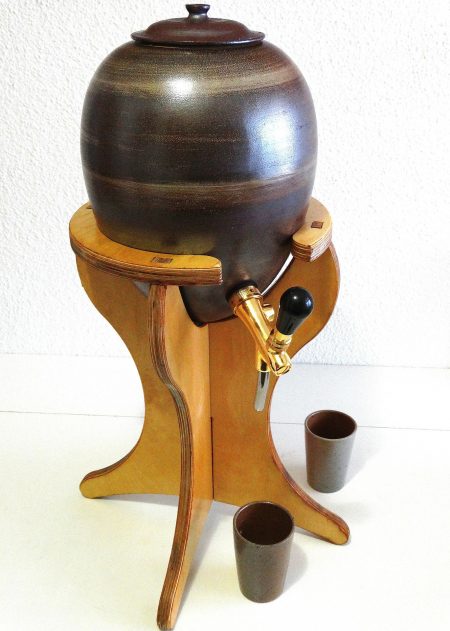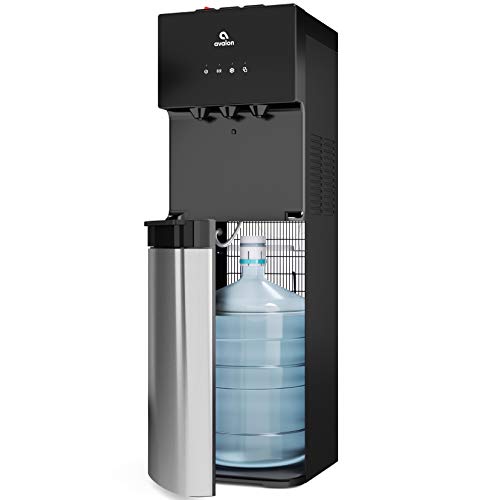The process of cleaning a water dispenser is a straightforward one. If you are trying to find out how to do this, you probably already appreciate the need for cleaning your water dispenser occasionally.
Table of Contents
Why Is Cleaning Your Water Dispenser Necessary?
Cleaning your water dispenser is necessary to prevent the breeding of mold in your dispenser. When you do not clean the water dispenser, it can expose you to different health hazards.
This is because water from the bottle goes into the reservoir before it comes out through the tap.
Some people may think cleaning water dispensers is not necessary, after all, the bottles get changed frequently. This is not true.
It is recommended that you clean your water reservoir once every two months. Better still, you can clean it every time you change a bottle.
How to Clean The Inside Of A Water Dispenser
How do you clean the inside of a water dispenser?
To clean the inside of a water dispenser, do the following:
1. Unplug the water dispenser from the power source to prevent electrocution.
2. Remove the bottle from the dispenser.
3. Check the mouth of the bottle for any sign of mildew. If there is, clean it out.
4. Mix 1 spoonful of vinegar or bleach in a gallon of water.
5. Dip a microfiber cloth in the cleaning mixture and clean the port that holds the water bottle.
6. Wipe it with a clean cloth and allow it to dry.
Bleach is a little bit more effective in getting rid of the bacteria. However, the cleaning agent you choose is entirely up to you. Choose a cleaning agent that won’t irritate your skin and whose smell you can handle better.
How do you wash the water guard?
Follow these steps to wash the water guard:
1. Take out the water guard if your water dispenser has one.
2. Wash it in your kitchen sink with some dish soap and water.
3. Rinse it with a lot of water and allow it to dry completely.
The water guard is that thing that punctures a hole in the bottle when you place it on the dispenser.
You can disinfect the water guard with the cleaning mixture you’ve made if you want to. Remember to rinse the water guard with a lot of water afterward and allow it to dry completely.
How do you wash your water reservoir?
The following are steps to take when you want to wash your water reservoir:
1. Empty the water reservoir.
2. Mix a spoonful of vinegar or bleach in a gallon of water.
3. Pour the cleaning mixture inside the water reservoir and allow it to sit for 2 minutes.
4. Wash it with a microfiber cloth.
5. Drain out the water and rinse thoroughly with clean water to remove the cleaning solution.
6. Allow it to dry completely.
7. Assemble the water reservior on the water dispenser.
Do not leave the cleaning solution in the water reservoir for a long time as it could stick to the reservoir and change the taste of your water. Alternatively, you can clean the water reservoir with hot water mixed with a spoonful of bleach or vinegar. Then scrub the reservoir with a soft sponge.
Since you are using vinegar/bleach for the cleaning, you can do your cleaning outside. If you would rather do your cleaning indoors, consider placing a piece of rag on the floor to protect the area where you’ll be doing the cleaning.
Check out these interesting articles from our previous post:
- How to Help A Hoarder Clean
- How to Clean Your Furnace
- How Often To Dry Clean Pants
- How to Clean A Pillow Top Mattress
- How to Clean The Speaker On An iPhone
- How to Clean Fingerprints Off Flat Screen TV
Video: How to Clean A Water Dispenser
This video will show you how to clean your water dispenser thoroughly.
How to Clean The Body Of A Water Dispenser
How do you clean the body of a water dispenser?
To clean the body of a water dispenser, do the following:
1. Wash the body of the water dispenser with dish soap, water, and soft sponge.
2. Clean the taps thoroughly with vinegar or bleach solution.
3. Rinse off with clean water to prevent mold or mildew growth.
4. Wash the plate that houses your cup thoroughly with dish soap and water. Rinse afterward.
5. Pat the machine dry with a dry microfiber cloth.
6. Plug the water dispenser back to the power source.
Note: Do not mix vinegar with bleach when cleaning your water dispenser. It is either one or the other. Mixing them is disastrous rather than effective.
How to Clean A Water Dispenser – Related FAQs
Does Mold Grow In Water Dispensers?
Mold can grow in water dispensers. Most times, the mold grows on the outer part of your water dispenser, usually hard to reach areas. Soon, it gives off a foul smell spreading germs and bacteria.
In this state, the water dispenser is not safe to use unless it is cleaned. To remove the mold from your water dispenser, do the following:
- Use a pipe cleaner or a small brush to scrub the hard to reach areas of the dispenser.
- Use hot water and dish soap to clean the mold-infested areas in the dispenser.
- Allow the soapy solution to soak the moldy areas before you scrub.
- Rinse the water dispenser thoroughly with clean water.
How to Install A Water Dispenser?
To install a water dispenser, do the following:
- Place the water dispenser at least 2 inches away from the wall for good ventilation.
- Wipe the neck and cap of the water bottle to ensure there is no dirt.
- Remove the tamper seal from the bottle cap.
- Load the water bottle onto the probe, making sure that the bottle is aligned with the water dispenser.
- Put a cup under the hot water dispensing faucet and depress the faucet until water flows freely. Repeat this process for the cold water dispensing faucet.
- Plug the water dispenser into the power supply.
- Install the drip tray and dispense water.
Make sure you install the water dispenser on a level floor to support its weight.
What Are The Advantages Of Water Dispenser?
The advantages of water dispensers are:
- Water dispensers are convenient as they can give you cold or hot water just by pushing a button.
- Water dispensers are usually portable, thereby making their storage easy.
- They give you safe and clean water.
- The dispensers require no plumbing.
- They are easy to clean and only require a change of parts when needed.
- Water dispensers are more affordable than buying bottled water all the time. So, you get to save a lot of money.
What Are The Disadvantages Of Water Dispenser?
The following are disadvantages of water dispenser:
- Some water dispensers are made of harmful plastic material. So, water from the dispenser will be hazardous to your health.
- Water dispensers are not so cost-effective as you need to change its filter after some time.
- Refilling empty water bottles is harmful to your health. This is because most water dispensers are meant to be used once.
- Water dispensers can become a breeding zone for mold or mildew if not cleaned regularly and properly.
It is important you check the quality of plastic the water dispenser is made of before you buy one.
How Do You Get Hot Water From A Water Dispenser?
Follow these steps to get hot water from a water dispenser:
- Plug the water dispenser into the power supply outlet.
- Put a cup in an upright position.
- Locate the 3 buttons at the top of the water dispenser that controls the temperature of the water.
- Depress the button that controls hot water. This button is usually red.
When you press the red button, it starts blinking. This indicates that the water is heating up. The red light stops blinking when the water is hot.
How Do You Fix Your Water Dispenser?
To fix your water dispenser, do the following:
- Unplug the water dispenser. Then remove the water reservoir.
- Clean the coils inside the water reservoir thoroughly with a mild cleaning solution.
- Drain out leftover water and wipe the water reservoir.
- Plug the water dispenser back into the socket but don’t replace the water reservoir.
- Turn off the reset switch at the back of the water dispenser.
- Unplug the water dispenser and leave it like that overnight.
- Plug the dispenser the next day and leave it for 3 to 5 hours before replacing the water reservoir.
If any part is faulty, replace it immediately to prevent total damage to the water dispenser.




1 thought on “How to Clean A Water Dispenser”